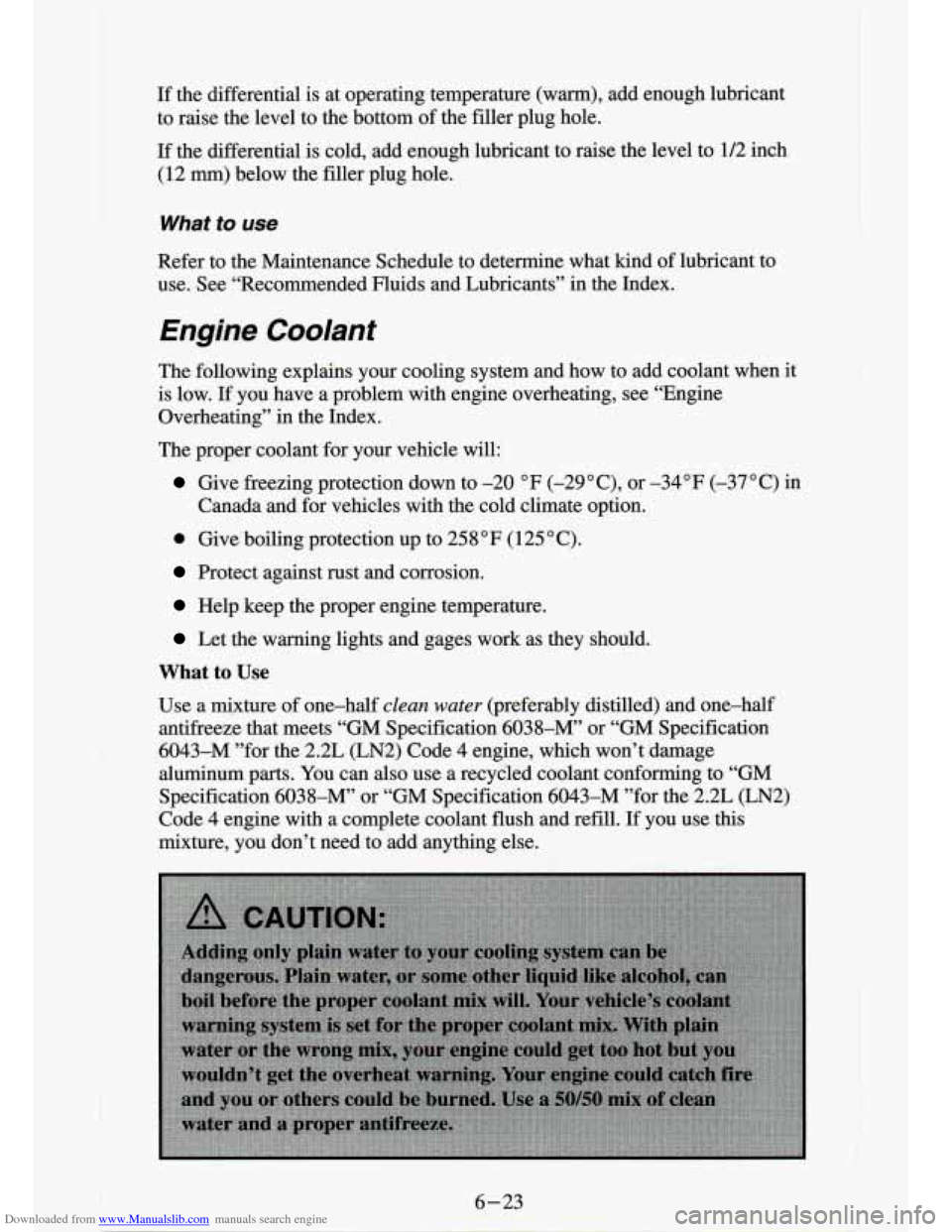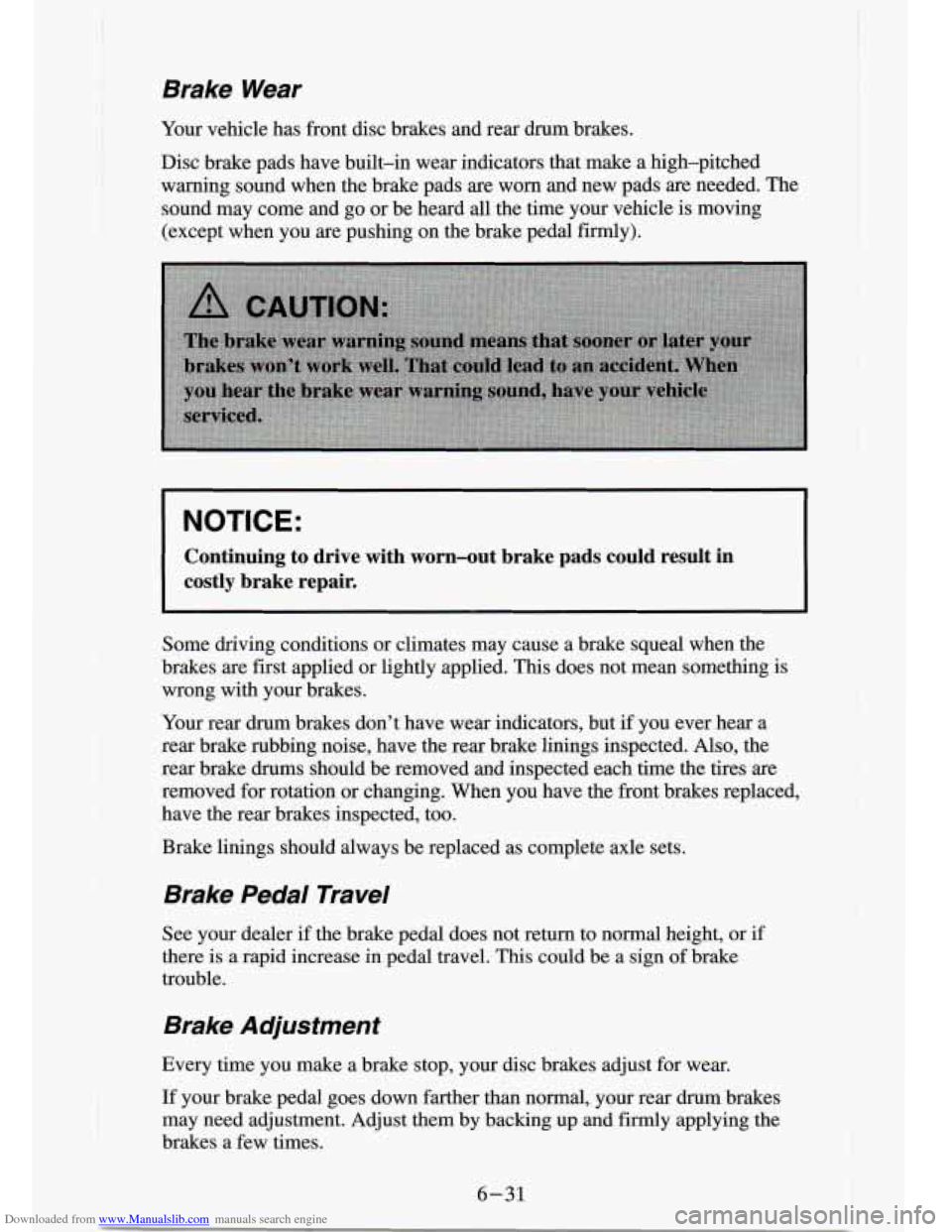Page 238 of 340
Downloaded from www.Manualslib.com manuals search engine Hydraulic Clutch
The hydraulic clutch in your vehicle is self-adjusting. A slight amount of
play
(1/4 inch to 1/2 inch) in the pedal is normal.
When to Check and What to Use
Refer to the Maintenance Schedule to determine how often you should
check the fluid level in your clutch master cylinder reservoir and what to
add. See “Owner Checks and Services” and “Recommended F\
luids and
Lubricants” in the Index.
How to check
The proper fluid should be added if the level does not reach the bottom of
the diaphragm when it’s in place in the reservoir. See the \
instructions on the
reservoir cap.
Rear Axle
When to Check and Change Lubricant
Refer to the Maintenance Schedule to determine how often to ch\
eck the
lubricant and when to change it. See “Scheduled Maintenance Services” in
the Index.
6-20 I i
Page 241 of 340

Downloaded from www.Manualslib.com manuals search engine If the differential is at operating temperature (w,arm), add enou\
gh lubricant
to raise the level to the bottom of the filler plug hole.
If the differential is cold, add enough lubricant to raise the level to 1/2 inch
(12
mm) below the filler plug hole.
What to use
Refer to the Maintenance Schedule to determine what kind of lubricant to
use. See “Recommended Fluids and Lubricants” in the Index.
Engine Coolant
The following explains your cooling system and how to add coolant \
when it
is low.
If you have a problem with engine overheating, see “Engine
Overheating” in the Index.
The proper coolant for your vehicle will:
Give freezing protection down to -20 “F (-29” C), or -34°F (-37 “C) in
Canada and for vehicles with the cold climate option.
e Give boiling protection up to 258°F (125°C).
Protect against rust and corrosion.
Help keep the proper engine temperature.
Let the warning lights and gages work as they should.
What to Use
Use a mi,xture of one-half clean water (preferably distilled) and one-half
antifreeze that meets “GM Specification 603%” or “GM Specification
6043-M ”for the 2.2L (LN2) Code 4 engine, which won’t damage
aluminum parts. You can also use
a recycled coolant conforming to “GM
Specification 603%” or “GM Specification 6043-M ”for the 2.2L (LN2)
Code 4 engine with a complete coolant flush and refill.
If you use this
mixture, you don’t need to add anything else.
6-23
Page 249 of 340

Downloaded from www.Manualslib.com manuals search engine Brake Wear
Your vehicle has front disc brakes and rear drum brakes.
Disc brake pads have built-in wear indicators that make a high\
-pitched warning sound when the brake pads are worn and new pads are \
needed. The
sound may come and go or be heard
all the time your vehicle is moving
(except when you -are pushing on the brake pedal
firmly).
I NOTICE:
I
Continuing to drive with worn-out brake pads could result in
costly brake repair.
Some driving conditions or climates may cause a brake squeal w\
hen the
brakes are first applied or lightly applied. This does not mean something is
wrong with your brakes.
Your rear
drum brakes don’t have wear indicators, but if you ever hear a
rear brake rabbing noise, have the rear brake linings inspected. Also, the
rear brake drums should be removed and inspected each time the\
tires itre
removed for rotation or changing. When you have the front brakes replaced,
have the rear brakes inspected, too.
Brake linings should always be replaced
as complete axle sets.
Brake Pedal Travel
See your dealer if the brake pedal does not return to normal height, o\
r if
there is a rapid increase in pedal travel. This could be a sign of brake
trouble.
Brake Adjustment
Every time you make a brake stop, your disc brakes adjust for wear.
If your brake pedal goes down farther than normal, your rear drum brakes
may need adjustment. Adjust them by backing up and
firmly applying the
brakes a few times.
6-31
Page 251 of 340
Downloaded from www.Manualslib.com manuals search engine Fluid Leak Check
After the vehcle has been parked for awhile, inspect the surface under the
vehicle
for water, oil, fuel OX other fluids. Water dripping from the air
conditioning system after it has been used is normal. If you notice fuel leaks
or fumes, the causes should be found and corrected at once.
Bulb Replacement
Before you replace any bulbs, be sure that all the lights are off and the
engine isn’t running.
Halogen Bulbs
NOTICE:
Page 252 of 340
Downloaded from www.Manualslib.com manuals search engine Composite Headlights
1. Open the hood.
2. Remove the screws at the top
of the radiator
support.
3. Pull the headlight
lens assembly
out.
4. Unplug the
electrical
connector.
1 5. Turn the bulb to
6-34
Page 253 of 340
Downloaded from www.Manualslib.com manuals search engine 6. Put the new bulb
into the headlight
lens assembly
and turn it to the
right until
it is
tight.
7. Plug in the electrical
connector.
8. Put the headlight lens assembly back into the vehicle. Install and
tighten the screws.
Sealed Beam Headlights
1. Remove the
screws from the
headlight retainer.
2. Pull the headlight
out
and remove
the retainer.
3. Unplug and
remove the
headlight.
4. Plug in the new headlight and put it in place.
5. Put the retainer on the headlight and install and tighten the \
screws.
6-35
Page 254 of 340
Downloaded from www.Manualslib.com manuals search engine Front ParklTurn Signal Lights
(Composite and Sealed Beam)
If you have fog lamps, the fog lamp bracket must be removed \
before you can replace the front park/turn signal lights.
1. Reach under the bumper and behind the parking/turn signal light\
assembly.
3. Pull the bulb out of the socket.
_. Turn the socket to
the left
and pull it
out.
4. Push the new bulb into the socket.
5. Put the socket back into the parking/turn signal light assembly and turn
it to the right until it locks in place.
6-36
Page 255 of 340
Downloaded from www.Manualslib.com manuals search engine Rear Lights
1. Open the tailgate.
2. Remove the light assembly screws
near the tailgate
latch and pull out
the light
assembly.
3. Pull the light assembly away
from the pickup
side panel.
4. Turn the socket to
the left to remove
it.
Push the tab in
while you turn
the socket.
5. Pull the bulb out.
6. Push the new bulb into the socket.
7. Put the socket into the light assembly and turn the socket to the right
until it locks in place.
8. Replace the light assembly. Install and tighten the screws.
9. Close the tailgate.
6-37